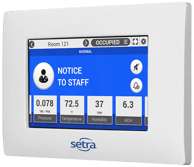When USP <800> became official in December 2019, it did not become enforceable like USP <797>. Rather, it is advisory and meant to serve as a guideline for handling hazardous drugs (HDs). With this guideline in place, here are some actions pharmacies should take today.
Risk Assessment
Although not required for facilities to adopt, USP <800> was developed to help protect patients and healthcare staff who might encounter HDs. USP <800> is only applicable to the handling of HDs when there is risk of exposure. Facilities that handle HDs should assess this risk to determine the best way to handle HDs.
USP <800> states low and medium risk HDs can be prepared in an unclassified containment segregated compounding area (C-SCA). A C-SCA must have:
- Fixed walls
- External ventilation
- 12 air changes per hour (ACH) minimum
- Negative pressure between 0.01 and 0.03" WC
Proper Preparation and Storage
If a facility preps a small number of HDs, they can compound the drugs in a non-negative pressure space only if there are two levels of containment in use.
If a facility compounds any antineoplastic HDs, said drugs must be stored properly to prevent contamination and exposure to personnel. To store antineoplastic HDs properly, they must be in an externally ventilated negative pressure room with a minimum of 12 ACH.
Sterile HDs
Any containment secondary engineering controls (C-SECs) used for preparing sterile HDs must be vented externally. Sterile HDs must be compounded in a C-SEC with at least an ISO Class 5 rating. Even when not in use, a C-SEC must maintain its negative pressure and ACH.
Under USP <797>, a pressure gauge and daily monitoring are required for sterile compounding. For nonsterile compounding, facilities should follow applicable federal, state, and local regulations.
Monitoring Pharmacies
Setra FLEX is suitable for compounding pharmacy applications because it can handle multiple rooms and environmental parameters. When HD, non-HD, anterooms, and core areas all need monitoring, Setra FLEX can show differential room pressure, temperature, humidity, and air changes on one screen.


